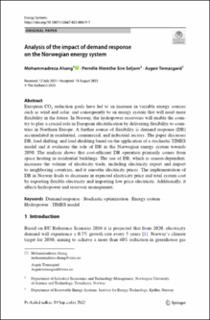| dc.contributor.author | Ahang, Mohammadreza | |
| dc.contributor.author | Seljom, Pernille | |
| dc.contributor.author | Tomasgard, Asgeir | |
| dc.date.accessioned | 2023-11-21T13:08:22Z | |
| dc.date.available | 2023-11-21T13:08:22Z | |
| dc.date.created | 2023-09-23T12:50:32Z | |
| dc.date.issued | 2023 | |
| dc.identifier.issn | 1868-3967 | |
| dc.identifier.uri | https://hdl.handle.net/11250/3103857 | |
| dc.description.abstract | European CO2 reduction goals have led to an increase in variable energy sources such as wind and solar, and consequently to an energy system that will need more flexibility in the future. In Norway, the hydropower reservoirs will enable the country to play a crucial role in European electrification by delivering flexibility to countries in Northern Europe. A further source of flexibility is demand response (DR) accumulated in residential, commercial, and industrial sectors. The paper discusses DR, load shifting, and load shedding based on the application of a stochastic TIMES model and it evaluates the role of DR in the Norwegian energy system towards 2050. The analysis shows that cost-efficient DR operation primarily comes from space heating in residential buildings. The use of DR, which is season-dependent, increases the volume of electricity trade, including electricity export and import to neighboring countries, and it smooths electricity prices. The implementation of DR in Norway leads to decreases in expected electricity price and total system cost by exporting flexible electricity and importing low price electricity. Additionally, it affects hydropower and reservoir management. | en_US |
| dc.language.iso | eng | en_US |
| dc.publisher | Springer | en_US |
| dc.rights | Navngivelse 4.0 Internasjonal | * |
| dc.rights.uri | http://creativecommons.org/licenses/by/4.0/deed.no | * |
| dc.title | Analysis of the impact of demand response on the Norwegian energy system | en_US |
| dc.title.alternative | Analysis of the impact of demand response on the Norwegian energy system | en_US |
| dc.type | Journal article | en_US |
| dc.type | Peer reviewed | en_US |
| dc.description.version | publishedVersion | en_US |
| dc.source.journal | Energy Systems, Springer Verlag | en_US |
| dc.identifier.doi | 10.1007/s12667-023-00619-7 | |
| dc.identifier.cristin | 2178161 | |
| dc.relation.project | Norges forskningsråd: 268097 | en_US |
| cristin.ispublished | true | |
| cristin.fulltext | original | |
| cristin.qualitycode | 1 | |

